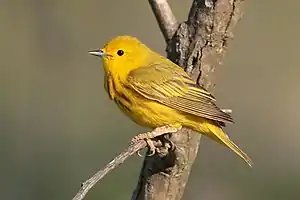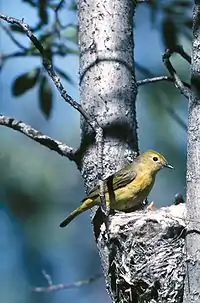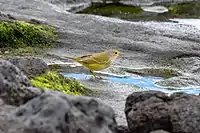Goldwaldsänger
Der Goldwaldsänger (Setophaga petechia) ist ein kleiner insektenfressender Vogel aus der Gattung der Baumwaldsänger (Setophaga) in der Familie der Waldsänger (Parulidae).
| Goldwaldsänger | ||||||||||||
|---|---|---|---|---|---|---|---|---|---|---|---|---|

Goldwaldsänger (Setophaga petechia) | ||||||||||||
| Systematik | ||||||||||||
| ||||||||||||
| Wissenschaftlicher Name | ||||||||||||
| Setophaga petechia | ||||||||||||
| (Linnaeus, 1766) |
Merkmale
Goldwaldsänger haben ein goldgelbes Federkleid, das an der Brust bei dem Männchen mit kastanienbraunen Streifen durchzogen ist. Bei dem Weibchen fehlen die Streifen oder sie sind nicht so stark ausgeprägt wie bei dem Männchen. Unterarten des Goldwaldsängers tragen auch rostfarbene Streifen an den Flanken. Arten, die in Mangrovenwäldern beheimatet sind, haben eine kastanienfarbene Krone auf dem Kopf. Insgesamt ist das Federkleid bei dem Weibchen stumpfer. Die Oberseite und die Flügeldecken sind gelbgrün bis olivgrün. An den Enden der Schwanzfedern befinden sich gelbe Punkte. Ihre dünnen spitzen Schnäbel sind grau. Die Körpergröße beträgt je nach Unterart zwischen zehn und achtzehn Zentimeter.
Ernährung
Sie ernähren sich vorwiegend von Insekten, die sie von den Blättern picken oder im Flug fangen. Gelegentlich fressen sie auch Früchte.
Fortpflanzung
Zwischen Mai bis Juni werden drei bis sechs gräuliche bis grünlich weiße, mit dunklen Flecken überzogene Eier ausgebrütet. Dafür wird ein Nest aus Rinde, Gras, Haaren und Spinnweben auf einem Baum in einer Astgabel oder in einem Gebüsch erbaut. Ein häufiger Brutschmarotzer des Goldwaldsängers ist der Braunkopf-Kuhstärling (Molothrus ater).
Vorkommen und Bedrohung

Insgesamt gibt es zwölf Unterarten, die den Westindischen Raum und das amerikanische Festland bewohnen. Die anpassungsfähigen Goldwaldsänger brüten in der Regel in feuchten Lebensräumen mit hohem Insektenvorkommen unter anderem in Nordamerika, von Alaska und Nordkanada bis nach Mexiko, wo sie die südlich gelegenen Mangroven bewohnen. Andere Lebensräume befinden sich an den Randbereichen von Sümpfen, Seen, Flüssen, bei Weiden, in Gärten oder auch an Waldrändern. Im Winter ziehen sie in den Süden von Kalifornien und Florida bis in Gebiete nach Brasilien, Bolivien und Peru. Unterarten kommen des Weiteren auf den großen Antillen vor, von Kuba, Puerto Rico, Jamaika und Hispaniola. Eine Art kommt auf den Galapagosinseln vor, eine weitere auf der Cocos-Insel. Als seltener Gast kommt er auch in Westeuropa vor.
Von den zwölf Arten ist besonders der Barbados-Goldwaldsänger (Setophaga petechia petechia), dessen Lebensraum sich auf der Insel Barbados befindet, stark gefährdet durch eingeschleppte Raubtiere, Brutschmarotzer und durch Zerstörung seiner Lebensräume durch den Tourismus. Von den Barbados-Goldwaldsängern gibt es nur noch wenige Brutpaare.
Unterarten

Es sind vierunddreißig Unterarten bekannt:[1]
- Setophaga petechia oraria (Parkes & Dickerman, 1967)[2] – Diese Unterart kommt im Osten Mexikos vor
- Setophaga petechia bryanti (Ridgway, 1873)[3] – Diese Unterart ist vom Südosten Mexikos bis in den Süden Nicaraguas verbreitet.
- Setophaga petechia erithachorides (Baird, SF, 1858)[4] – Diese Subspezies kommt vom Osten Costa Ricas bis in den Norden Kolumbiens vor.
- Setophaga petechia chrysendeta (Wetmore, 1946)[5] – Das Verbreitungsgebiet dieser Unterart reicht vom Nordosten Kolumbiens bis in den extremen Nordosten Venezuelas.
- Setophaga petechia paraguanae (Phelps & Gilliard, 1941)[6] – Diese Unterart kommt auf der Halbinsel Paraguaná vor.
- Setophaga petechia cienagae (Zimmer, JT & Phelps, 1944)[7] – Diese Subspezies kommt im Nordwesten und Norden von Venezuela und die angrenzenden Inseln vor.
- Setophaga petechia castaneiceps (Ridgway, 1885)[8] – Die Unterart ist im südlichen Niederkalifornien verbreitet.
- Setophaga petechia rhizophorae (van Rossem, 1935)[9] – Diese Unterart kommt in Sonora und Sinaloa vor.
- Setophaga petechia phillipsi (Browning, 1994)[10] – Diese Subspezies kommt im Westen Mexikos bis nach Honduras vor.
- Setophaga petechia xanthotera (Todd, 1924)[11] – Diese Unterart ist im Westen Nicaraguas und dem Westen Costa Ricas verbreitet.
- Setophaga petechia aithocorys (Olson, 1980)[12] – Diese Unterart ist im Südwesten Panama und der Coiba-Insel verbreitet.
- Setophaga petechia iguanae (Olson, 1980)[13] – Diese Unterart kommt auf der Iguana-Insel südlich von Panama vor.
- Setophaga petechia aequatorialis (Sundevall, 1869)[14] – Diese Unterart ist im südlichen zentralen Panama verbreitet.
- Setophaga petechia jubaris (Olson, 1980)[15] – Das Verbreitungsgebiet dieser Subspezies reicht über den Südosten Panamas bis ins westliche zentrale Kolumbien.
- Setophaga petechia peruviana (Sundevall, 1869)[14] – Diese Unterart ist vom Südwesten Kolumbiens bis in den Nordwesten Perus verbreitet.
- Setophaga petechia aureola (Gould, 1839)[16] – Diese Unterart kommt auf der Coco- und den Galapagosinseln vor.
- Setophaga petechia ruficapilla (Gmelin, JF, 1789)[17] – Diese Unterart kommt auf Martinique vor.
- Setophaga petechia rufivertex (Ridgway, 1885)[18] – Diese Unterart kommt auf Cozumel vor.
- Setophaga petechia armouri (Greenway, 1933)[19] – Diese Subspezies kommt auf der Providencia-Insel vor.
- Setophaga petechia flavida (Cory, 1887)[20] – Diese Unterart ist auf der San Andrés-Insel verbreitet.
- Setophaga petechia eoa (Gosse, 1847)[21] – Diese Unterart ist auf den Kaimaninseln und auf Jamaica verbreitet.
- Setophaga petechia gundlachi (Baird, SF, 1865)[22] – Das Verbreitungsgebiet dieser Unterart ist Florida Keys, Kuba und die dazugehörende Isla de la Juventud.
- Setophaga petechia flaviceps (Chapman, 1892)[23] – Diese Unterart kommt auf den Bahamas vor.
- Setophaga petechia albicollis (Gmelin, JF, 1789)[24] – Diese Unterart kommt auf Hispaniola und den nahe gelegenen Inseln vor.
- Setophaga petechia chlora (Browning, 1994)[25] – Diese Unterart kommt auf den Cayos Siete Hermanos vor.
- Setophaga petechia solaris (Wetmore, 1929)[26] – Diese Unterart kommt auf der Île de la Gonâve vor.
- Setophaga petechia bartholemica (Sundevall, 1869)[27] – Das Verbreitungsgebiet dieser Subspezies ist Puerto Rico, die Jungferninseln und die nördlichen Teil der Kleinen Antillen.
- Setophaga petechia melanoptera (Lawrence, 1879)[28] – Diese Unterart kommt im zentralen Teil der Kleinen Antillen vor.
- Setophaga petechia babad (Bond, 1927)[29] – Diese Unterart kommt auf St. Lucia vor.
- Setophaga petechia petechia (Linnaeus, 1766)[30] – Die Nominatform kommt auf Barbados vor.
- Setophaga petechia alsiosa (Peters, JL, 1926)[31] – Diese Subspezies kommt auf den Grenadinen vor.
- Setophaga petechia rufopileata (Ridgway, 1884)[32] – Das Verbreitungsgebiet dieser Unterart ist Aruba, die Niederländischen Antillen und weitere Inseln nördlich von Venezuela.
- Setophaga petechia obscura (Cory, 1909)[33] – Diese Unterart kommt auf Las Aves, Los Roques und La Orchila vor.
- Setophaga petechia aurifrons (Phelps & Phelps Jr, 1950)[34] – Das Verbreitungsgebiet dieser Unterart umfasst den Nordosten Venezuelas und die angrenzenden Inseln.
Literatur
- Jon Curson, David Quinn, David Beadle: New World Warblers. Helm, London 1994, ISBN 0-7136-3932-6.
- Carl von Linné: Systema Naturae per Regna Tria Naturae, Secundum Classes, Ordines, Genera, Species, Cum Characteribus, Differentiis, Synonymis, Locis. 12. Auflage. Band 1. Laurentii Salvii, Stockholm 1766 (biodiversitylibrary.org).
- Johann Friedrich Gmelin: Systema Naturae per Regna Tria Naturae, Secundum Classes, Ordines, Genera, Species, Cum Characteribus, Differentiis, Synonymis, Locis. Band 1, Nr. 2. Georg Emanuel Beer, Leipzig 1789 (biodiversitylibrary.org).
- James Bond: A New Golden Warbler From the Island of St. Lucia, B. W. I. In: The Auk. Band 23, Nr. 4, 1927, S. 571–572 (englisch, sora.unm.edu [PDF; 115 kB; abgerufen am 3. April 2015]).
- Charles Barney Cory: Descriptions of Six Supposed New Species of Birds From the Islands of Old Providence and St. Andrews, Caribbean Sea. In: The Auk. Band 4, Nr. 3, 1887, S. 177–180 (englisch, sora.unm.edu [PDF; 139 kB; abgerufen am 3. April 2015]).
- Charles Barney Cory: The Birds of the Leeward Islands, Caribbean Sea. In: Field Museum of Natural History Publication 137 (= Ornithological Series). Band 1, Nr. 5, 1909, S. 193–255 (biodiversitylibrary.org [abgerufen am 4. April 2015]).
- Storrs Lovejoy Olson: Geographic Variation In The Yellow Warblers Dendroica-Petechia Parulidae Of The Pacific Coast Of Middle America And South America. In: Proceedings of The Biological Society of Washington. Band 93, 1980, S. 473–480 (biodiversitylibrary.org [abgerufen am 3. April 2015]).
- Marvin Ralph Browning: A Taxonomic Review Of Dendroica petechia (Yellow warbler) (Aves, Parulinae). In: Proceedings of The Biological Society of Washington. Band 107, 1997, S. 27–51 (biodiversitylibrary.org [abgerufen am 3. April 2015]).
- Alexander Wetmore: Descriptions of four new forms of birds forms of birds from Hisponiola. In: Smithsonian miscellaneous collections. Band 81, Nr. 13, 1929, S. 1–4 (biodiversitylibrary.org [abgerufen am 4. April 2015]).
- Alexander Wetmore: New Forms of Birds from Panama and Colombia. In: Proceedings of The Biological Society of Washington. Band 59, 1946, S. 49–54 (biodiversitylibrary.org).
- Robert Ridgway: On some new forms of American Birds. In: The American Naturalist, an Illustrated Magazine of Natural History. Band 7, 1873, S. 602–619 (biodiversitylibrary.org).
- Robert Ridgway: On a collection of birds made by Messrs. J. E. Benedict and W. Nye, of the United States Fish Commission steamer Albatross. In: Proceedings of the United States National Museum. Band 7, Nr. 420, 1884, S. 172–180 (biodiversitylibrary.org).
- Robert Ridgway: A review of the American “golden warblers”. In: Proceedings of the United States National Museum. Band 8, Nr. 522, 1885, S. 348–350 (biodiversitylibrary.org).
- Robert Ridgway: Description of Some New Species of Birds From Cozumel Island, Yucatan. In: Proceedings of The Biological Society of Washington. Band 3, 1885, S. 21–24 (biodiversitylibrary.org).
- Walter Edmond Clyde Todd: Descriptions of eight new neotropical birds. In: Proceedings of The Biological Society of Washington. Band 37, 1924, S. 121–124 (biodiversitylibrary.org).
- George Newbold Lawrence: Catalogue of a collection of birds obtained in Guadeloupe for the Smithonian Institution by Mr. Fred. A. Ober. In: Proceedings of the United States National Museum. Band 1, Nr. 57, 1879, S. 449–462 (biodiversitylibrary.org).
- Adriaan Joseph van Rossem: The Mangrove Warbler of North-Western Mexico. In: Transactions of the San Diego Society of Natural History. Band 8, Nr. 10, 1935, S. 67–68 (biodiversitylibrary.org).
- Carl Jakob Sundevall: Öfversigt af fogelslägtet Dendroeca. In: Öfversigt af Kongl. Vetenskaps-akademiens forhandlingar. Band 26, Nr. 6, 1869, S. 605–618 (biodiversitylibrary.org).
- James Lee Peters: A new race of the Golden Warbler from the West Indies. In: Proceedings of the New England Zoölogical Club. Band 9, 1926, S. 41.
- James Cowan Greenway: A name for the Golden Warbler of Old Providence Island. In: Proceedings of the New England Zoölogical Club. Band 13, 1933, S. 63–64.
- John Gould in Charles Darwin: The zoology of the voyage of H.M.S. Beagle, under the command of Captain Fitzroy, R.N., during the years 1832–1836. Published with the Approval of The Lords Commissioners of her Majesty’s Treasury. Band 3, Lieferung 11. Smith, Elder & Co, London 1841 (biodiversitylibrary.org).
- William Henry Phelps, William Henry Phelps Jr.: Lista de las aves de Venezuela con su distribución, Parte 2. Passeriforme. In: Boletín de la Sociedad Venezolana de Ciencias Naturales. Band 12, 1950, S. 1–427.
- John Todd Zimmer, William Henry Phelps: New species and subspecies of birds from Venezuela. In: American Museum novitates. Nr. 1270, 1944, S. 1–16 (digitallibrary.amnh.org [PDF; 2,7 MB; abgerufen am 3. April 2015]).
- William Henry Phelps, Ernest Thomas Gilliard: Seventeen new birds from Venezuela. In: American Museum novitates. Nr. 1153, 1941, S. 1–18 (digitallibrary.amnh.org [PDF; 2,7 MB; abgerufen am 3. April 2015]).
- Philip Henry Gosse: The birds of Jamaica. J. Van Voorst, London 1847 (biodiversitylibrary.org).
- Kenneth Carroll Parkes, Robert William Dickerman: A new subspecies of Mangrove Warbler (Dendroica petechia) from México. In: Annals of the Carnegie Museum. Band 39, Nr. 5, 1967, S. 85–89.
- Spencer Fullerton Baird: Reports of explorations and surveys, to ascertain the most practicable and economical route for a railroad from the Mississippi River to the Pacific Ocean. Band 9. A. O. P. Nicholson, Washington 1858 (quod.lib.umich.edu [abgerufen am 4. April 2015]).
- Spencer Fullerton Baird: Review of American birds, in the Museum of the Smithsonian Institution. In: Smithsonian miscellaneous collections. Nr. 181, 1864, S. 199 ff. (books.google.de).
- Frank Michler Chapman: Notes on birds and mammals observed near Trinidad, Cuba; with remarks on the origin of West Indian bird-life. In: Bulletin of the American Museum of Natural History. Band 4, Nr. 16, 1882, S. 279–330 (digitallibrary.amnh.org [PDF; 4,2 MB; abgerufen am 4. April 2015]).
Weblinks
- Setophaga petechia in der Roten Liste gefährdeter Arten der IUCN 2008. Eingestellt von: BirdLife International, 2008. Abgerufen am 2. Januar 2009.
- Videos, Fotos und Tonaufnahmen zu Setophaga petechia in der Internet Bird Collection
- Federn des Goldwaldsängers
Einzelbelege
- IOC World Bird List New World warblers & oropendolas
- Kenneth Carroll Parkes, S. 87.
- Robert Ridgway (1873), S. 606.
- Spencer Fullerton Baird (1858), S. 283.
- Alexander Wetmore (1946), S. 52.
- William H. Phelps u. a. (1941), S. 10.
- John Todd Zimmer u. a., S. 14.
- Robert Ridgway: A review of the American “golden warblers”. 1885, S. 350.
- Adriaan Joseph van Rossem, S. 67.
- Marvin Ralph Browning, S. 45.
- Walter Edmond Clyde Todd, S. 123.
- Storrs Lovejoy Olson, S. 474.
- Storrs Lovejoy Olson, S. 475.
- Carl Jakob Sundevall, S. 609.
- Storrs Lovejoy Olson, S. 478.
- John Gould, S. 86, Tafel 28.
- Johann Friedrich Gmelin, S. 971.
- Robert Ridgway: Description of Some New Species of Birds From Cozumel Island, Yucatan. 1885, S. 21.
- James Cowan Greenway, S. 63.
- Charles Barney Cory (1887), S. 179.
- Philip Henry Gosse, S. 158.
- Spencer Fullerton Baird (1865), S. 194, 197.
- Frank Michler Chapman, S. 310.
- Johann Friedrich Gmelin, S. 983.
- Marvin Ralph Browning, S. 39.
- Alexander Wetmore (1929), S. 1.
- Carl Jakob Sundevall, S. 607.
- George Newbold Lawrence, S. 453.
- James Bond, S. 571.
- Carl von Linné, S. 334.
- James Lee Peters, S. 41.
- Robert Ridgway (1884), S. 173.
- Charles Barney Cory (1909), S. 217.
- William H. Phelps u. a. (1950), S. 21.